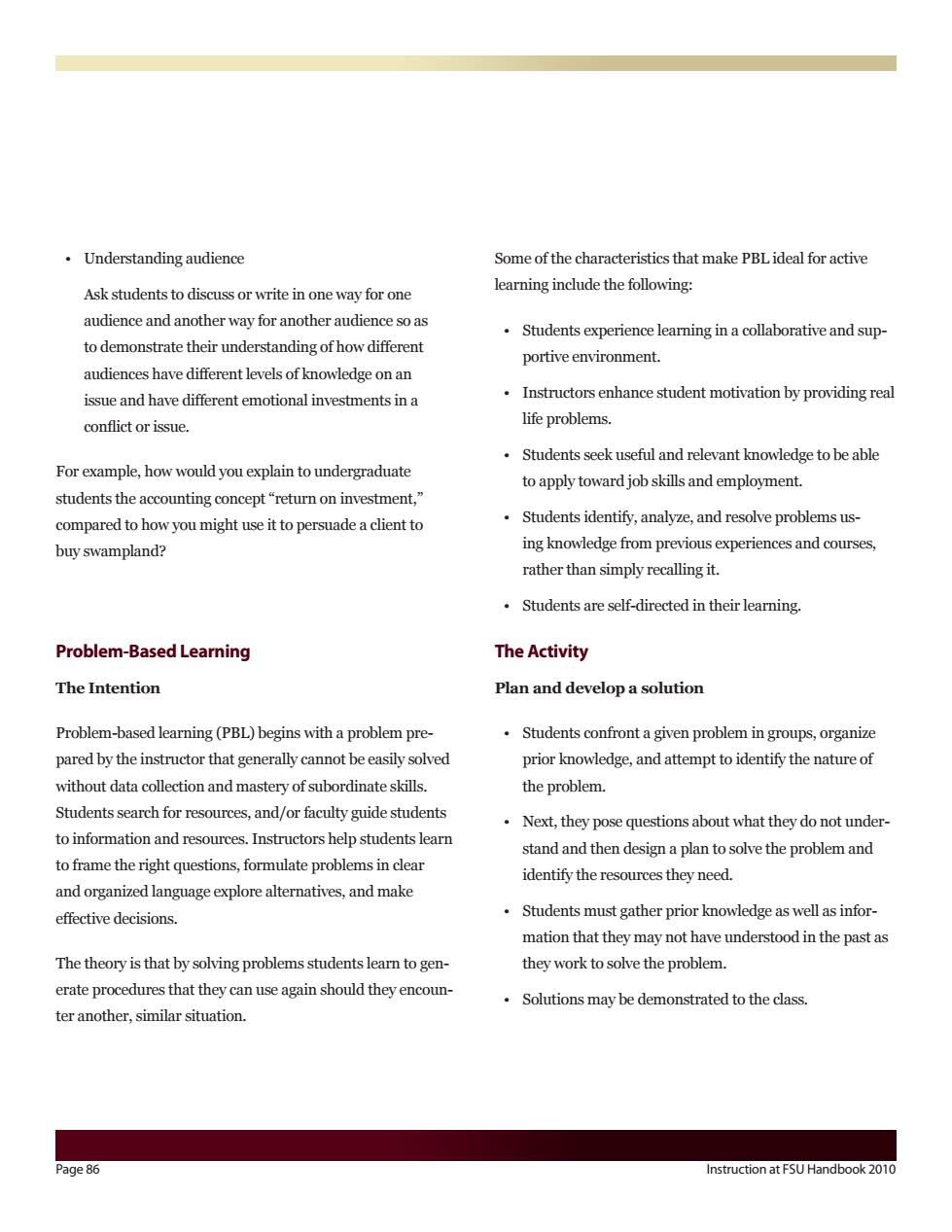正在加载图片...

.Understanding audience Some of the characteristics that make PBLideal for active Ask students to discuss or write in one way for one learning include the following: audience and another way for another audience so as Students experience learning in a collaborative and sup- to demonstrate their understanding of how different portive environment. audiences have different levels of knowledge on an issue and have different emotional investments ina Instructors enhance student motivation by providing real conflict or issue. life problems. Students seek useful and relevant knowledge to be abl For example,how would you explain to undergraduate to apply toward job skills and employment. students the accounting concept"return on investment," compaedtothorwJoumigtuetoperladeadieto Students identify,analyze,and resolve problems us- buy swampland? ing knowledge from previous experiences and courses rather than simply recalling it. .Students are self-directed in their learning. Problem-Based Learning The Activity The Intention Plan and develop a solution Problem-based learning(PBL)begins with a problem pre- Students confront a given problem in groups,organize pared by the instructor that generally cannot be easily solved prior knowledge,and attempt to identify the nature of without data collection and mastery of subordinate skills. the problem. Students search for resources,and/or faculty guide students Next,they pose questions about what they do not under to information and resources.Instructors help students learn stand and then design a plan to solve the problem and to frame the right questions,formulate problems in clear identify the resources they need. and organized language explore alternatives,and make effective decisions. Students must gather prior knowledge as well as infor- mation that they may not have understood in the past as The theory is that by solving problems students learn to gen- they work to solve the problem. erate procedures that they can use again should they encoun- Solutions may be demonstrated to the class ter another.similar situation age 86 Instruction at FSU Handbook 2010Page 86 Instruction at FSU Handbook 2010 • Understanding audience Ask students to discuss or write in one way for one audience and another way for another audience so as to demonstrate their understanding of how different audiences have different levels of knowledge on an issue and have different emotional investments in a conflict or issue. For example, how would you explain to undergraduate students the accounting concept “return on investment,” compared to how you might use it to persuade a client to buy swampland? Problem-Based Learning The Intention Problem-based learning (PBL) begins with a problem prepared by the instructor that generally cannot be easily solved without data collection and mastery of subordinate skills. Students search for resources, and/or faculty guide students to information and resources. Instructors help students learn to frame the right questions, formulate problems in clear and organized language explore alternatives, and make effective decisions. The theory is that by solving problems students learn to generate procedures that they can use again should they encounter another, similar situation. Some of the characteristics that make PBL ideal for active learning include the following: • Students experience learning in a collaborative and supportive environment. • Instructors enhance student motivation by providing real life problems. • Students seek useful and relevant knowledge to be able to apply toward job skills and employment. • Students identify, analyze, and resolve problems using knowledge from previous experiences and courses, rather than simply recalling it. • Students are self-directed in their learning. The Activity Plan and develop a solution • Students confront a given problem in groups, organize prior knowledge, and attempt to identify the nature of the problem. • Next, they pose questions about what they do not understand and then design a plan to solve the problem and identify the resources they need. • Students must gather prior knowledge as well as information that they may not have understood in the past as they work to solve the problem. • Solutions may be demonstrated to the class